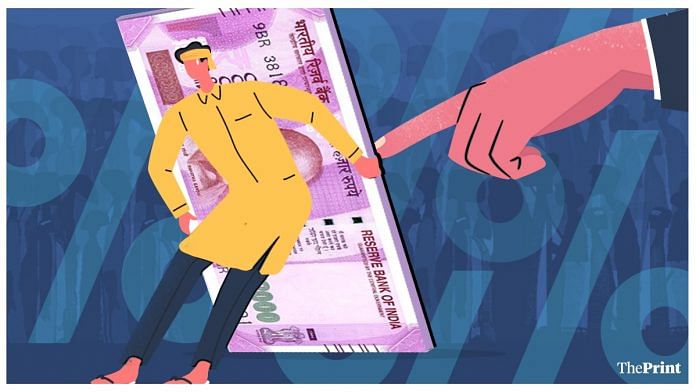Credit (alternatively, loans or debt) is a concept as old as time. Different faiths, prophets, theologists and philosophers worldwide have propagated their beliefs about debt, some outrightly proscribing it, while others distinguishing between good and bad credit.
Economists are also divided, with some viewing increased appetite for credit as an indicator of economic growth, and others with skepticism. Notwithstanding these differences, individuals, households, governments and enterprises around the world continue to regularly seek credit.
Given this reality, we attempt to explain its role in the finances of households and when it is suitable, with a special focus on India’s low-income households.
Households can save up, save through, or save down to afford things they want to buy. Saving up or through refer to gradual accumulation of money to be spent in the future whenever need arises.
All the conventional saving and deposit accounts, mutual fund SIPs, and insurance products are examples of financial instruments through which households save up or through. On the other hand, saving down refers to seeking loans to fund immediate needs and repaying them later using future earnings.
However, not all households have the luxury to choose.
Low-income households are often forced to save down as their insufficient and unstable earnings make it difficult to save up or through. As per the 2018 All-India Debt and Investment Survey (AIDIS), households allocated less than 10 per cent of their wealth towards saving, while more than 40 per cent of households sought loans.
When do households seek credit? For households, some are expected expenses, like paying school fees or buying a new business equipment. They can plan on funding them by saving up, saving down, or a combination of both. But they often experience unexpected shocks, like their primary earner losing their job or any member getting hospitalised.
During such circumstances, low-income households especially have no alternative but to seek loans. At other times, households also spend on investments that increase their earnings or reduce/stabilise their expenditure in the long run. Since these investments are expected to improve their future financial situation, credit is often used to fund them. Credit therefore plays a crucial role in the financial lives of households in different scenarios.
Also read: Why financial service providers, policy makers must evolve to better serve low-income households
When is credit suitable, and conversely, when is it unsuitable? Suitability of a financial product or service is the extent to which it matches the financial situation, need, goals, and the risk capacity of the customer to whom it is being sold. At the bare minimum, credit is suitable for a household if it can help sustain or improve its well-being and the household can repay it.
Well-being is when a household can manage its finances and have confidence in its financial future, and repayment capacity is its debt obligation as a share of its disposable income. If this ratio is reasonable, credit is suitable, and if it is high, it is unsuitable as the household may become over-indebted.
An overindebted household may be forced to resort to negative coping strategies, ranging from reduced food intake to forgoing essential expenses, that can cause tremendous distress and hamper its well-being.
Ideally, households should be able to assess their financial situation and only seek credit when suitable. But biases such as overestimating their future repayment capacity or neglecting the future consequences of their current decisions, lack of alternatives to deal with shocks, aggressive selling of loans by competing lenders can all push them to take unsuitable loans.
According to the AIDIS 2018, the loan obligation of low-income households as a share of their total wealth, i.e., their debt-to-asset ratio, is very high (39.1 per cent for rural and 549 per cent for urban households).
Since these households already endure tremendous stress managing their day-to-day finances, the constant mental accounting needed to assess their financial situation could add significantly to their cognitive load. Therefore, the responsibility of ensuring they take only suitable loans should lie with the lenders.
The Reserve Bank of India (RBI) has also acknowledged this by including the ‘Right to Suitability’ in its Charter of Customer Rights, requiring financial service providers (FSPs) to assess the financial circumstances of customers and only offer suitable products.
However, FSPs (lenders) also face challenges in ascertaining the suitability of credit, such as absence of, limited, or incomplete credit history of the household. They are also compelled to make inapt credit decisions due to competition from other lenders and their own ambitious disbursement targets.
A 2016 study by Dvara Research of low-income households in Tamil Nadu’s Krishnagiri district showed that 21 per cent of them were over-indebted. The proliferation of digital lending in recent years has exacerbated this concern, with many reports already emerging of increased over-indebtedness and distress among borrowers, and of lenders indulging in malpractices during debt recovery.
The RBI has taken cognizance of the need to regulate the credit market better and ensure that households are not over-burdened by their loan obligations because of inadequate or casual appraisal processes, by enforcing a modified regulatory framework for microfinance loans and guidelines on digital lending.
But lenders and households who do not fall under these guidelines have no such protections, leaving room for ambiguity.
Millions of India’s low-income and otherwise financially excluded households are entering and interacting with the formal financial system through credit. Therefore, care must be taken by lenders, regulators, and policymakers alike to ensure that credit only furthers, not hampers, their financial well-being.
Natasha D’cruze is Research Associate and Rakshith Ponnathpur is Research & Data Analytics Associate, Dvara Research.
The article is part of our series of financial explainers in partnership with Dvara Research.
Views are personal.
Also read: What is the ‘Jan Dhan Account-Aadhaar-Mobile’ trinity & has it aided India’s war on poverty?



